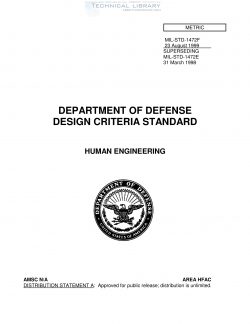MIL-STD-1472F
- Version
- 671 Downloads
- 1.93 MB File Size
- 1 File Count
- March 7, 2017 Create Date
- March 7, 2017 Last Updated
Department of Defence, Design Criteria Standard - Human Engineering

1.1 Scope. This standard establishes general human engineering design criteria for military systems, subsystems, equipment and facilities. 1.2 Purpose. The purpose of this standard is to present human engineering design criteria, principles, and practices to achieve mission success through integration of the human into the system, subsystem, equipment, and facility, and achieve effectiveness, simplicity, efficiency, reliability, and safety of system operation, training, and maintenance. 1.3 Application. This standard is applicable to the design of all systems, subsystems, equipment and facilities, except where provisions relating to aircraft design conflict with crew system design requirements or guidelines ofJSSG-2010. Nothing in this standard is to be construed as limiting the selection of hardware, materials, or processes to the specific items described herein. Unless otherwise stated in specific provisions, this standard applies to design of systems, subsystems, equipment and facilities for use by both men and women. This standard is not intended to be a criterion for limiting use of materiel already in the field in areas such as lift repetition or temperature exposure time. Where the procuring activity establishes use by male personnel exclusively, the paragraphs listed in Table I are changed as noted therein.
1.4 Force limits. If it is known that an item is to be used by an already established military occupational specialty, for which physical qualification requirements for entry into that specialty are also established, any discrepancy between the force criteria of this standard and the physical qualification requirements will be resolved in favor ofthe latter. In this event, the least stringent physical qualification requirement of all specialties which may operate, maintain, transport, supply, move, lift or otherwise manipulate the item in the manner being considered, will be used as a maximum design force limit. If such physical qualification requirements for entry into a specialty do not cover the task covered herein, the criteria herein will govern. I .5 Manufacturing tolerances When manufacturing tolerances are not perceptible to the user, this standard will not be construed as preventing the use of components whose dimensions are within a normal manufacturing upper or lower limit tolerance of the dimensions specified herein.
| File | Action |
|---|---|
| MIL-STD-1472F Human Engineering.pdf | Download |

Comment On This Post